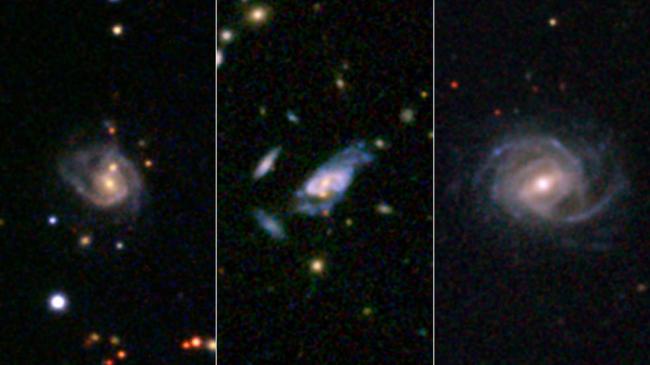
Super spirals have long hidden in plain sight by mimicking the appearance of typical spiral galaxies. A new study using archived NASA data reveals these seemingly nearby objects are in fact distant, behemoth versions of everyday spirals. Rare, super spiral galaxies present researchers with the major mystery of how such giants could have arisen.
"We have found a previously unrecognized class of spiral galaxies that are as luminous and massive as the biggest, brightest galaxies we know of," said Patrick Ogle, an astrophysicist at the Infrared Processing and Analysis Center (IPAC) at the California Institute of Technology in Pasadena and lead author of a new paper on the findings published in The Astrophysical Journal. "It's as if we have just discovered a new land animal stomping around that is the size of an elephant but had shockingly gone unnoticed by zoologists."
Ogle and colleagues chanced upon super spirals as they searched for extremely luminous, massive galaxies in the NASA/IPAC Extragalactic Database (NED), an online repository containing information on over 100 million galaxies. NED brings together a wealth of data from many different projects, including ultraviolet light observations from the Galaxy Evolution Explorer, visible light from Sloan Digital Sky Survey, infrared light from the Two Micron All-Sky Survey, and links to data from other missions such as Spitzer and the Wide-ï¬eld Infrared Survey Explorer, or WISE.
"Remarkably, the finding of super spiral galaxies came out of purely analyzing the contents of the NASA/IPAC Extragalactic Database, thus reaping the benefits of the careful, systematic merging of data from many sources on the same galaxies," said George Helou, a study co-author and the executive director of IPAC. "NED is surely holding many more such nuggets of information, and it is up to us scientists to ask the right questions to bring them out."
Ogle, Helou and their colleagues expected that humongous, mature galaxies called ellipticals -- so named for their football-like shapes -- would dominate their search within NED for the most luminous galaxies. But a tremendous surprise lay in store for the scientists.
In a sample of approximately 800,000 galaxies no more than 3.5 billion light-years from Earth, 53 of the brightest galaxies intriguingly had a spiral, rather than elliptical, shape. The researchers double-checked the distances to the spiral galaxies and saw that none were nearby -- even the closest lay some 1.2 billion light-years away. With the correct distance estimates in hand, the stunning properties of this newfound batch of whirlpool-shaped galaxies came to light.
Super spirals can shine with anywhere from eight to 14 times the brightness of the Milky Way. They possess as much as 10 times our galaxy's mass. Their gleaming, starry disks stretch from twice to even four times the width of the Milky Way galaxy's approximately 100,000 light-year-wide disk, with the largest super spiral spanning a whopping 440,000 light-years. Super spirals also give off copious ultraviolet and mid-infrared light, signifying a breakneck pace of churning out new stars. Their star formation rate is as high as 30 times that of our own run-of-the-mill galaxy.
According to established astrophysical theory, spiral galaxies should not be able to attain any of these feats because their size and star-making potential are limited. As spiral galaxies grow by gravitationally attracting fresh, cool gas from intergalactic space, their masses reach a tipping point in which any newly captured gas rushes in too rapidly. This headlong gas heats up and prevents subsequent star formation in a process known as "quenching." Bucking this conventional wisdom, though, super spirals remain unquenched.
A vital hint about the potential origin of super spirals is that four out of the 53 seen by Ogle and colleagues clearly contain two galactic nuclei, instead of just one as usual. Double nuclei, which look like two egg yolks frying in a pan, are a telltale sign of two galaxies having just merged together. Conventionally, mergers of spiral galaxies are destined to become bloated, elliptical galaxies. Yet Ogle and colleagues speculate that a special merger involving two, gas-rich spiral galaxies could see their pooled gases settle down into a new, larger stellar disk -- presto, a super spiral.
"Super spirals could fundamentally change our understanding of the formation and evolution of the most massive galaxies," said Ogle. "We have much to learn from these newly identified, galactic leviathans."
Other authors of the new study are Lauranne Lanz of IPAC and Cyril Nader, an undergraduate student at the University of California, Los Angeles, who worked on this project during a summer internship at IPAC.
Image credits: SDSS
Support Our Journalism
We cannot do without you.. your contribution supports unbiased journalism
IBNS is not driven by any ism- not wokeism, not racism, not skewed secularism, not hyper right-wing or left liberal ideals, nor by any hardline religious beliefs or hyper nationalism. We want to serve you good old objective news, as they are. We do not judge or preach. We let people decide for themselves. We only try to present factual and well-sourced news.







